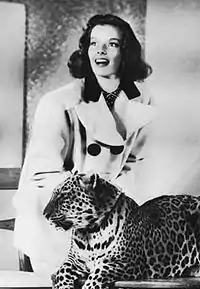A Manic Pixie Dream Girl (MPDG) is a stock character type in fiction, usually depicted as a young woman with eccentric personality quirks who serves as the romantic interest for a male protagonist. The term was coined by film critic Nathan Rabin after observing Kirsten Dunst's character in Elizabethtown (2005). Rabin criticized the type as one-dimensional, existing only to provide emotional support to the protagonist, or to teach him important life lessons, while receiving nothing in return. The term has since entered the general vernacular.
Origin
Film critic Nathan Rabin coined the term in 2007 in his review of the 2005 film Elizabethtown for The A.V. Club. In discussing Kirsten Dunst's character, he said "Dunst embodies a character type I like to call The Manic Pixie Dream Girl," a character who "exists solely in the fevered imaginations of sensitive writer-directors to teach broodingly soulful young men to embrace life and its infinite mysteries and adventures."[1]

A year later, The A.V. Club ran a piece listing 16 characters they deemed MPDGs, including Katharine Hepburn's character in Bringing Up Baby; Goldie Hawn's character, Jill, in Butterflies Are Free; and Winona Ryder's character in Autumn in New York[2]. Thereafter, the new term spread throughout other media, including National Public Radio and Jezebel.[3]
Response
In an interview in New York about her 2012 film Ruby Sparks, actress and screenwriter Zoe Kazan expressed skepticism over the use of the term, noting that its use could be reductive, diminutive, and misogynistic. She disagreed that Hepburn's character in Bringing Up Baby is a MPDG: "I think that to lump together all individual, original quirky women under that rubric is to erase all difference."[4]
In a December 2012 video, AllMovie critic Cammila Collar embraced the term, noting that its pejorative use is mainly directed at writers who do not give these female characters more to do.[5]
In December 2012, Slate's Aisha Harris posited that "critiques of the MPDG may have become more common than the archetype itself," suggesting that filmmakers had been forced to become "self-aware about such characters" and that the trope had largely disappeared from film.[6]
In July 2013, Kat Stoeffel, for The Cut, argued that the term has its uses, but that it has sometimes been deployed in ways that are sexist. For example, she noted that "it was levied, criminally, at Diane Keaton in Annie Hall and Zooey Deschanel, the actual person. How could a real person's defining trait be a lack of interior life?"[7]
Similar sentiments were elucidated by Monika Bartyzel for The Week in April 2013, who wrote "this once-useful piece of critical shorthand has devolved into laziness and sexism". Bartyzel argues that "'Manic Pixie Dream Girl' was useful when it commented on the superficiality of female characterizations in male-dominated journeys, but it has since devolved into a pejorative way to deride unique women in fiction and reality".
In July 2014, writing for Salon, Rabin stated that the term "Manic Pixie Dream Girl" had frequently been deployed in ways that are sexist and had become as much of a cliché as the trope itself. Rabin acknowledged that the phrase has its uses in specific, limited contexts, but overwhelming popularity had limited its effectiveness. Rabin concluded by saying that the term should be "put to rest."[8]
Male variation
A male version of this trope, the Manic Pixie Dream Boy or Manic Pixie Dream Guy, was found in Augustus Waters from the film version of The Fault in Our Stars (2014); he was given this title in a 2014 Vulture article, in which Matt Patches stated, "he's a bad boy, he's a sweetheart, he's a dumb jock, he's a nerd, he's a philosopher, he's a poet, he's a victim, he's a survivor, he's everything everyone wants in their lives, and he's a fallacious notion of what we can actually have in our lives."[9]
The Manic Pixie Dream Boy trope has also been pointed out in sitcoms such as Parks and Recreation and 30 Rock. The female protagonists of these shows marry men (Adam Scott's Ben Wyatt and James Marsden's Criss Chros, respectively), who, according to a 2012 Grantland article, "patiently [tamp] down her stubbornness and temper while appreciating her quirks, helping her to become her best possible self."[10]
See also
References
- ↑ Rabin, Nathan (January 25, 2007). "My Year Of Flops, Case File 1: Elizabethtown: The Bataan Death March of Whimsy". The A.V. Club. Retrieved January 5, 2010.
- ↑ "Wild things: 16 films featuring Manic Pixie Dream Girls". The A.V. Club. August 4, 2008.
- ↑ Ulaby, Neda (October 9, 2008). "Manic Pixie Dream Girls: A Cinematic Scourge?". NPR.
- ↑ Greco, Patti (July 23, 2012). "Zoe Kazan on Writing Ruby Sparks and Why You Should Never Call Her a 'Manic Pixie Dream Girl'". Vulture. Retrieved June 26, 2016.
- ↑ Collar, Cammila (December 14, 2012). Semantic Breakdown: The Manic Pixie Dream Bitch. YouTube. Retrieved June 26, 2016.
- ↑ Harris, Aisha (December 5, 2012). "Is the Manic Pixie Dream Girl Dead?". Slate. Retrieved September 16, 2014.
- ↑ Stoeffel, Kat. "The 'Manic Pixie Dream Girl' Has Died". The Cut. New York Media LLC. Retrieved September 16, 2014.
- ↑ Rabin, Nathan (July 15, 2014). "I'm sorry for coining the phrase "Manic Pixie Dream Girl": In 2007, I invented the term in a review. Then I watched in queasy disbelief as it seemed to take over pop culture". Salon. Retrieved June 26, 2016.
- ↑ Patches, Matt. "He's Perfect, He's Awful: The Case Against The Fault in Our Stars' Gus Waters". Vulture. New York Magazine. Retrieved September 17, 2014.
- ↑ Lambert, Molly (3 December 2012). "1D Internet Fantasies: Liz Lemon, One Direction, and the Rise of the Manic Pixie Dream Guy". Grantland. Retrieved September 17, 2014.